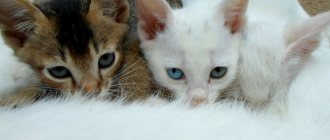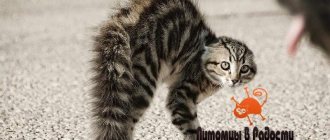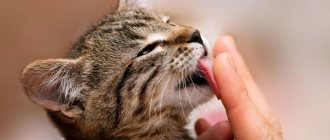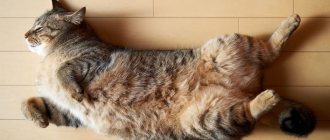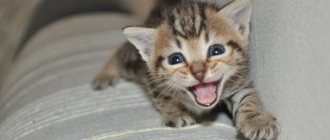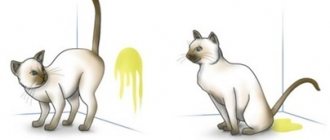Surely, each of us has come across such an amazing “phenomenon” as a cat’s purring - most often our four-legged animals purr when we stroke them (however, there are many other reasons underlying a cat’s purring).
Let's try to figure out in what cases our mustachioed friends make such unusual sounds, and how this affects us.
There is a huge amount of research being done on how cats purr. As a result, scientists noticed that cats most often make such sounds when they are happy: they have just eaten, are basking in the sun, or are being caressed by their owner...
An interesting fact is that some domestic cats purr when they are near a sick person. Previously, it was believed that in this way the cat showed its sympathy and support to its owner. However, scientists have found that the vibrations emitted by animals have a healing effect. Those. it is possible that in this way the four-legged animals are trying to heal their beloved owner.
There is a theory that the low-frequency vibrations (20~30 Hz, depending on the breed) emitted by a cat stimulate its brain to release a hormone that promotes pain relief and healing. This explains situations where a wounded cat (in pain) or a cat purring during childbirth.
In some cases, cats purr to attract the owner's attention. In this situation, the animal may be hungry or the pet may miss human affection.
It has been recorded that kittens can purr already at the age of 2 days - probably in this way, the babies tell their mother that everything is fine with them. They purr mainly either during or after feeding. And the purring of an adult cat, in turn, lets the kittens know that they are safe and can feel free.
It turns out that a cat’s purring can express a whole range of emotions: pleasure, fear, boredom, love for the owner.
There is another interesting theory put forward by Californian scientists. It says that purring is a result of the “cat lifestyle”: due to the fact that our lazy pets can sleep or bask on a pillow for 18 hours a day, this negatively affects the bones of animals, and purring helps strengthen stagnant joints and allows muscles to atrophy.
What to do if your cat stops purring?
There are no cats in the world that cannot purr.
Even lions, cheetahs, leopards and other impressive members of the cat family can purr and do it with pleasure. An exception applies to those animals that were born with defects in the development of the respiratory tract or received injuries that affected the breathing process. If your cat has stopped purring, something may be bothering her. Before you worry and take your pet to the vet, observe him carefully. Perhaps your pet is tired of your company and purrs when alone. This behavior is often observed in cats that do not have a private place to rest.
A cat may not purr or purr very rarely if it is kept in very comfortable conditions. Evolution has taught four-legged animals to use energy wisely, and meowing and purring are energy expenditures. Wild cats sleep most of the day and are only active when hunting. However, every living creature needs physical activity to maintain muscle tone and metabolism.
Long-term observation of wild cats revealed an unexpected fact. A cat can use monotonous, quiet purring as light exercise. It turns out that the cat is active, but spends a minimum of energy.
Do cats purr if they feel bad?
Not many owners know that cats purr to relieve stress or pain. Quadrupeds purr in the last minutes of their lives to make them easier to care for. There is a catchphrase: “Cats come and go from life to the sound of purring...”.
The purring of cats has attracted the attention of scientists for many years. Research has revealed that the sound range of a cat's purring ranges from 25 to 100 Hz.
These frequencies promote bone healing, relieve muscle pain and reduce stress.
Tests were carried out on humans. Results from control groups of people treated with cat purring proved that low-frequency ultrasounds significantly accelerated the healing of bone fractures. Purring high frequencies helped people calm down, reduce muscle pain and blood pressure.
Timbre of purring
Purring can vary in intensity and timbre. By the volume of a cat's purring, one can understand and determine the emotional mood of a mustachioed pet.
Scientists distinguish several types of purring:
- A dissatisfied loud purr signals pain.
- If a cat is nervous, its quiet rumbling gradually intensifies and turns into a heart-rending meow. When experiencing stress and discomfort, the cat wags its tail, purrs and bites at the same time.
- With loud rumbling sounds, a nursing cat makes it clear to humans or other animals not to approach its offspring.
- A monotonous, calm, loud purring is a sign that the cat is feeling good and comfortable.
- Gradually subsiding rumbling means that the cat is gradually losing interest in what is happening. If the cat has stopped purring, she has received a portion of affection, a treat, is in a calm state or begins to fall asleep.
Important! The way cats purr is completely independent of breed, genetic, and hereditary factors. The volume, timbre, and tonality of the sounds produced are individual for each animal and depend only on external factors and the mood of the mustachioed pet.
A quiet, gentle purring indicates that the cat is in an excellent mood and is experiencing positive emotions. A quiet, calm purring, which may be accompanied by light biting, can be heard if you caress a cat or pick it up. The pet is satisfied and thanks you with such sounds.
If a cat purrs quite loudly, this may mean that the animal is alarmed or worried about something. It is possible that the cat is in pain or is experiencing discomfort.
Let's look at the main causes of rumbling.
Many pets purr in order to calm themselves; through vibrations, the animal tries to relieve stress and normalize the heart rhythm. Cats often purr during transportation or examination by a doctor, but they can be twitchy and show aggression. Therefore, you should not impose your affection on the animal at such moments, because it is capable of attacking the owner. The difference between “good” and “evil” rumbling should be defined as follows:
- in a bad mood, a cat moves quickly and has sudden movements;
- the tail is slightly fluffed and moves in jerky movements;
- the animal does not rub against you, but tries to stay at a distance.
If we talk about the purring of cats during the period of bearing offspring, then the mechanism is much more complicated. The cat considers the birth of healthy offspring to be its main goal, so it can consider even the most harmless things to be a threat. This is manifested by the fact that the cat can sit calmly on your lap and purr, but when you try to stroke, turn over or remove it from its place, it scratches and bites
Therefore, during pregnancy, do not force your attention on the animal.
After the kittens are born, the purring sound helps calm the babies and let them know that the mother cat is nearby. The kittens, in turn, respond in kind. We can say that in this way, rumbling helps the family not to get lost and strengthen connections among themselves.
When separated from its owner for a long time, a cat is able to express the joy of meeting him; she not only purrs, but also rubs against clothes, leaving her marks.
During periods of emotional stress, cats may come to the owner and purr loudly, they trample their paws, rub, trying to attract attention. This is how an animal often says that it wants attention or to be played with.
Pets often beg for food in this way. The main reason why a cat comes, lies down on you and starts purring is basic cold. Yes exactly! Cat lovers perceive this behavior as a manifestation of love and trust, and this is partly true, because a cat will never lie down where it doesn’t like it. But these are one of the most heat-loving pets, and they perceive humans as one big hot water bottle. If you have a cat, think about why in the summer it is impossible to hold her in your arms for a long time, and she rarely comes on her own.
You can often see a cat licking itself intensively and purring loudly at the same time. The vibration, which penetrates the entire body of the animal, allows you to stimulate all the processes currently occurring in the body, and the secretion for “washing” is more actively produced.
Sometimes you may notice that your pet purrs for no particular reason, for example, in his sleep. In this way, the cat engages in passive exercise, because felines living at home do not receive much physical activity, and the vibrations stimulate the contraction of muscle tissue and prevent it from atrophying. This is the same reason why cats purr when they fall asleep.
Interesting Facts
While purring, it is impossible for a veterinarian to conduct a clinical examination of the animal: listen to the heartbeat, feel the pulse, conduct auscultation - everything inside vibrates and shakes so much. But there is a way to stop the chattering: it has been observed that pouring water causes the cat to stop its loud roulades.
Not all cats purr; for example, wild animals such as lions, tigers and leopards lack this ability.
A case was recorded when a small dog tried to make sounds somewhat reminiscent of purring. It soon turned out that as a puppy, she was raised by a cat.
Why do cats purr?
Purring is a rhythmic sound made by a cat. It can be continuous and/or vibrating. Pets purr on different occasions. Most often this happens at the moment of receiving positive emotions, when they are in a good mood or as a sign of gratitude (for example, for food or affection). The reason for purring may also be related to the pet’s character.
People are accustomed to the fact that cats purr, but wild representatives of the cat family - tigers, pumas, leopards, cheetahs, jaguars - can also do this.
In fact, the reason for purring is not entirely clear. Scientists have not yet reached a consensus on this issue. Sometimes animals purr when left alone, when they feel safe or when they are eating. The female can purr during childbirth, and the kittens can purr already on the second day after birth.
There is also a theory that this happens for the purpose of self-medication: while the animal’s brain is purring, it produces a special hormone that has a healing and relaxing effect, which is why some cats purr when they are in pain (wounded cats).
Scientists have found that the nature of these sounds depends on the cause - purring can be grateful, calm, impatient, etc.
An adult cat may purr when interacting with kittens - this indicates that she is happy, calm and takes care of her offspring with pleasure. In addition, the animal may purr if it asks for something, for example, to open a window or door, of course, hoping that this request will be granted. The reason for purring can be anything. Just as a person cries and laughs out of happiness or fear, so a cat expresses different emotions when it purrs.
Purring and rumbling
Until the 20th century, felines were unofficially divided into purring, growling, etc. The difference in timbre and character of sound depends on the structure of the hyoid bone (it is structured differently in all species). The conditional division took place in groups. For example, tigers, lions, etc. were classified as roarers. But later it became clear that there were too many exceptions in each group (for example, snow leopards purr), and such a division was abandoned.
Snow leopards, despite their menacing nature, can purr
Cat growling can be caused by aggression or fear. Cats growl more often - cats do not have to defend their territory so fiercely. And since the growl of a domestic cat is difficult to compare with the roar (of a lion, for example), these sounds can be called rumbling.
Video: how a cat growls
How an animal makes purring sounds
Scientists have not discovered a separate organ responsible for purring in cats, so the method of producing these sounds has long remained controversial. The following is now known: electrical impulses arise in the cerebral cortex, are sent to the vocal cords, the muscles located next to them tense, causing the hyoid bones to vibrate and sound is produced. Even though a cat's purr comes from the nose and mouth, it vibrates the entire body.
The frequency of purring depends on the circumstances (from 50 to 150 hertz). The tone and volume of the sound also differs in different cases. A satisfied cat purrs more quietly and tenderly.
Why do cats purr?
Not long ago, British scientists determined that cats can purr in order to improve their health or cure their owner, possibly another pet. Sound therapy has been known for a long time. It’s not for nothing that sick children are played classical music. The actual process is almost the same.
British scientists in a study found that the sound of a cat purring is observed in the range of 20-150 hertz. Moreover, from 20 to 140 - this purring is therapeutic. It has been found that such purring heals bone tissue, promotes restoration of the body, and also cures diseases of the heart and blood vessels.
White cat
Why do cats purr?
The issue of cats purring is much more complex and deeper than it seems at first glance. Understanding why your pet purrs will be a big step towards predicting his mood, meeting his needs and, above all, living a harmonious life with him. Below are some of the reasons why cats purr.
Reason #1: Purring as a means of communication
Cats communicate primarily through movement, but that doesn't mean they can't communicate through sounds. However, unlike humans, whose speech has evolved over many years, cats have to make do with just a few sounds they can produce - and purring is one of them.
One of the reasons your pet purrs is communication.
Did you know that cats can make many different purring sounds? For example, if your pet purrs due to hunger, then the purring is accompanied by a whimper, similar to the cry of a child. Sounds like these are hard to ignore
The idea is to appeal to the parental instinct in you and draw attention to the hungry animal
Reason #2: the bond between a mother and her kittens
A nursing mother is known to purr to communicate with her kittens. She uses purring as a lullaby to calm babies. This works much the same way as rocking or humming for babies.
Babies communicate with their mother by purring
Kittens begin to purr a few days after birth. At this time, their auditory and visual abilities are not yet fully functional. For young kittens, purring is a way of reassuring their mother that they are okay. Babies also purr to call out to their mother when they feel she is not around.
Reason #3: Manifesting Happiness and Satisfaction
A cat purrs when it is happy and content. This is due to her good health and satiety. A cat will purr while eating, and kittens will purr when their mother licks them. Tickling or a light massage also makes cats purr with pleasure.
A cat purrs when it is happy and content
These manifestations of feline pleasure can make us, their owners, happier. Cat purring is in the frequency range that relaxes people. It has been scientifically proven that cat caresses and purring vibrations have a calming effect on humans. Reducing tension correspondingly lowers blood pressure levels. This explains the benefits of cat companionship for your health.
Reason #4: Pain relief
Do you think cats only purr when they are happy and healthy? It is not always so. You should not ignore the signals that your pet gives, because the cause of purring may be illness. Purring can also be caused by your cat trying to relieve your pain.
Cats purr when they seek relief from pain.
- Cats tend to purr during labor. Purring triggers the release of endorphins in the animal's brain centers. This “happy hormone” acts as a powerful natural pain reliever and helps her relax. Purring is also an alternative to the agonizing screams that would attract predators in the wild.
- In addition, cats can purr in a range that helps speed up the healing of fractures and torn ligaments. These frequencies can also soothe sore muscles. The need for such skills is due to the fact that these animals sleep on average 16 hours a day. This prolonged inactivity contributes to decreased bone density and muscle strength. Seals counteract these processes by purring. This can also speed up a person’s healing. The purring frequencies are believed to be in the same range as the frequencies used in ultrasound devices to speed the healing of bone fractures in humans.
- If you have trouble breathing, try to breathe in sync with your cat's purring. The purring process imitates the normal dynamics of human breathing - thus the cat helps restore the normal rhythm of inhalation and exhalation.
However, don't try to imitate your cat's purring. If you have tried this before, then you must have already realized that it is impossible. You probably experienced shortness of breath after the first few seconds of trying in vain. The question arises: how do cats do this?
What are the benefits of purring?
There are opinions that purring has benefits and has a positive effect on the human body. The main ones are:
- soft sound with a special timbre, frequency 27-44 Hz, has a healing effect on the body;
- purring has a positive effect on the health and condition of bones;
- has a calming effect on a person;
- helps get rid of stress and relieve fatigue after work;
- sound vibrations affect human brain activity and help normalize blood pressure;
- a massage can be compared to an acupuncture session.
Some of these misconceptions have no scientific basis and are simple myths that have taken root in society. Having a cat in the house can have a positive impact on a child's development. According to statistics, children who had animals in childhood treat them better.
If a child has contact with a cat before the age of three, the allergens form a strong immunity to allergies. There are other statistics. People who have pets at home live on average 4-5 years longer than those who do not have pets.
How does purring occur?
For a long time, the purring of cats remained a mystery to humans. And even now it is not fully studied.
Initially, scientists tried to find a separate organ that is responsible for producing vibrating sound. But nothing suitable was found. Then they decided that the sound was coming from the cats' stomachs! But they quickly rejected this misconception.
The modern official version is that purring occurs due to the contraction and vibration of muscles that are located near the vocal cords. This is caused by the arrival of certain impulses from the animal’s brain.
A number of systems are used to create such a unique sound:
- nose;
- mouth;
- hyoid bones;
- ligaments
Sound and vibration originate between the base of the skull and the tongue, and then spread throughout the body.
Mr. Cat recommends: interesting facts
Purring is a process unique to the animal world. But among the purring ones there are their own records:
- The volume of the rumbling varies in the range from 16 to 100 dts.
- The English cat Merlin purrs four times louder than an ordinary pet. The sound is so loud that it drowns out a running hair dryer. Eyewitnesses compare the cat's purring to the sound of a landing plane.
- The kitten makes its first “murr” at the age of two days.
- The most “purring” country in the world is Australia, where there is a cat for every resident.
1111
How do cats purr?
We are able to observe the purring, understand the reasons and reasons for its occurrence. But what can we say about the mechanism for producing these purring sounds? Oddly enough, it has not been fully studied by scientists.
What is clear is that a special organ that would produce such sounds was not found in cats. Otherwise, instead of a clear answer, we are offered a number of scientifically based assumptions/theories:
- The purring is caused by the vibration of the cat's lungs.
- Occurs when there is a change in blood movement/circulation in the cat’s body.
- In recent studies, the purring mechanism is described as a sequence: “the appearance of electrical impulses in the cat’s cerebral cortex - the vocal cords receive these impulses - contraction of the muscles associated with them.”
How does the mechanism for producing purring sounds work?
The “purring apparatus” itself is a thinly connected hyoid bone, which is located between the base of the skull and the base of the tongue. But it is the contraction of the muscles near the vocal cords that causes them to vibrate, and, accordingly, the appearance of purring sounds.
At the same time, the cat’s mouth and nose participate in their reproduction, while the vibration spreads throughout its entire body. One of the features of purring is the inability to listen to the cat’s heartbeat and monitor its breathing.
If necessary, to stop the sounds of purring, it is recommended to turn on the water from the tap - while it flows, the cat stops purring.
Are only cats able to purr?
It is widely believed that purring is a privilege of the feline family. Indeed, each of its members, regardless of size, can make similar sounds, but in large representatives they are more like a roar and roar.
However, there are many species in the animal kingdom that have a similar ability. For example, species related to cats are cat-like hyenas and civets: mongooses, genets, civets. In a good mood, foxes and badgers, guinea pigs and squirrels purr while eating. Gorillas and sometimes even elephants rumble quite loudly.
How do cats purr?
Who would have thought that such a seemingly trivial question could plunge “great minds” into complete stupor. Until recently, scientists were simply unlucky: they were unable to unravel the mystery of how and why pets make sounds.
Hypotheses
Some suggested that the whole issue was in the vibration of the diaphragm or trachea, other pundits generally blamed the cat's belly for everything. But the whole point is that it was not possible to solve the puzzle due to the examination of immobilized animals that did not make a single sound.
Proven version
The modern theory is completely different from all previous guesses. A certain part of the brain is responsible for rumbling in cats, which sends impulses directly to the vocal cords.
Using special equipment, researchers determined the range of sounds produced by animals from 25 to 150 Hz. Thanks to this frequency, cats are able to heal their wounds and calm the nervous system.
Their baritone practically does not change, except that at certain moments the cats purr more intensely, and sometimes less so.
Why can't big cats purr? It's all about their physiology, because in small wild and domestic cats the hyoid bone is thin and can bend and vibrate. But their larger cousins, such as lions, have rough, thick bones and are covered with cartilage.
However, despite the fact that lions do not purr, this structure allows them to roar loudly, which is unusual for small cats or lynxes.
Cat purring - real sound therapy
We have already mentioned that cats often lie down on the owner’s sore spot and begin to purr. An animal can, for example, lie on the owner’s legs if they are “whining” about the weather. Or even lie on your head when the owner is tormented by a migraine. What does this mean, can pets really heal? It turns out that the purring of cats is therapeutic sound therapy.
Photo: Scottish Fold kitten | Dreamstime.com
A measured, quiet sound calms frayed nerves no worse than the sound of rain or the sound of a babbling stream. Felinologists believe that cats, with the help of special rumbling sounds, can treat the following ailments:
- Bone fractures, joint and muscle pain;
- Nervous disorders (depression, stress);
- Reduced immunity;
- Arterial hypertension;
- Diseases of the heart and blood vessels;
- Various inflammatory processes;
- Diseases of the stomach and/or intestines;
- Respiratory ailments.
Even though the sounds of rumbling help relieve, for example, joint pain or lower blood pressure, such sound therapy cannot be considered a full-fledged treatment; you will still need the help of a doctor. However, a cat's purring fights well against the same fatigue and nervousness.
Cat massage
There are many guesses why the pet purrs and tramples its owner with its paws. Here are some of them:
Memories of childhood, or “milk step” - kittens knead their mother with their paws while feeding to quickly obtain milk. This brings them pleasure and is associated in adults with a feeling of comfort, satiety and security.
Prepares a comfortable place to sleep - tramples the surface on which you are going to sleep for the greatest comfort. The owner's knees may well be suitable for this purpose.
Gratitude - in this way one can say “thank you” for delicious food, warm shelter, tenderness and affection.
Therapeutic massage is a common theory that this is how a cat treats its owner from ailments.
Stress relief – by purring and moving their paws, cats lift their spirits, relax and calm down.
Unfulfilled sexual instinct - one theory says that if an animal does not have a mate, it may show unambiguous interest.
Marks its property - cats have glands on their paw pads that secrete a secretion. This is one of the ways to convey to other animals that a person belongs to him.
Showing trust and love - the pet shows its owner its location, favor, openness and trust. Emphasizes your closeness with a person.
This massage soothes, relaxes and helps relieve stress. But what if claws are used? You can lightly press the cat towards you so that he lies down and stops trampling. You should not scold or drive out an animal if its trust and peace of mind are valuable. It’s better to just put a blanket or pillow on your knees in advance.
Causes
The first reason is pleasure. Kittens purr from warmth and satiety, adult cats purr from the affection of their owner. Animals show it not only by sound, but also, for example, by releasing their claws.
In addition, there are a number of other factors that can trigger purring:
- Demand for attention.
- Request for food.
- Relieving stress and pain, for example, during childbirth or severe wounds, fear.
- Expression of gratitude.
- Acquaintance.
- The joy of hunting.
Purring expresses more than just happiness
Some cats purr when they are excited or nervous. It happens that a purr scratches its beloved owner if he misunderstands the cat’s emotional state.
It happens that a cat purrs at a veterinarian's appointment. This is how he shows his dependence and consoles himself as best he can.
Observe all signs of the cat’s psychological and emotional state:
Position of ears and tail. Follow his gaze. Pay attention to your general body position.
If he's lounging on his back, paws up, eyes closed and purring at full volume, rest assured, he's happily demonstrating his complete satisfaction with life.
The owner must learn not only to enjoy the singing of his cat, but also to understand why he purrs:
- Wants to say something.
- Show your mood.
- Give a sign that there is a problem.
- Report the onset of illness.
Can purring cure a person?
Cat “music,” if not a complete cure, can significantly speed up recovery. Purring with a frequency of up to 140 hertz promotes the healing of various injuries. When bones and tendons are damaged, the pain subsides and the tissues slowly recover. If a person suffers from arthrosis, osteochondrosis or radiculitis, then a cat will help; if a person has ailments of internal organs (or systems), a cat will help.
Purring has a positive effect on the nervous system and calms the general condition of the body, so purr therapy is recommended for use in cases of stress, insomnia, rehabilitation of drug addicts and alcoholics (purring reduces withdrawal symptoms). In addition, such vibrations help improve blood circulation, normalize blood pressure and heartbeat, alleviate symptoms of gastrointestinal disorders (colitis, flatulence, gastritis, stomach ulcers, etc.), increase immunity - people who have cats are less likely to get colds diseases.
It is not necessary to ask the animal to lie down on the sore spot - often cats themselves detect the source of pain
Purring is especially useful at the moment when the cat is doing a “claw massage.” Thus, vibration, uniform sound and the effect of acupuncture have the greatest beneficial effect on human health.
How does purring occur?
Purring is a rhythmic, vibrating sound that lasts a long time. The source of this sound is cats. Typically, this ability is a cat's "secret weapon" with which they react to certain situations. It's not just cats that purr - some representatives of the animal world are capable of producing similar sounds. These animals include hyenas, badgers and mongooses.
The famous English writer Terry Prachett wrote about purring in his book “The Cat Without Fools.” Many people remember quotes from this work: “Rumbling is not a trifle” and “All is forgiven for cats for rumbling.” We can agree with this, because cats are capable of emitting gentle and touching vibrations, for which most owners forgive their pets for any mischief.
Cat owners value their pets for their wonderful purring ability, because with this ability they can calm a person down. Every cat owner knows that if his pet sits next to him to fall asleep and begins to purr, the person feels relaxed and falls asleep.
Scientists Robert Eklund, together with Gustav Peters and Elisabeth Duthie, working at Lund University, released a scientific paper that provided information on the frequency of purring of various members of the cat family. According to the information provided, the cheetah purrs with a frequency of 18.32-20.87 Hz, and the domestic cat produces sounds in the range of 21.98-150 Hz. In 2011, Eklund, along with Susanne Scholz, released another scientific paper in which they proved that different cat breeds purr within their own specific range.
There are several opinions regarding the purring mechanism. Experts put forward various versions.
- False vocal cords. The animal has simple vocal cords, with the help of which others hear the traditional “meow”. This sound can only be heard if the cat opens its mouth. And during the purring, the animal’s mouth is closed and the reproduced sound is formed due to vibration, which passes to special bones located under the tongue. With this option, a person hears sounds similar to a quietly working tractor.
- Sinuses. This variation is related to the functioning of the vascular system. Based on the emotional component, a change in blood pressure occurs, due to which vibration occurs in the cat’s chest. Frequency fluctuations occur in the cranial air sinuses and are translated into recognizable cat sounds. Large cat breeds have thicker sinuses, which are hidden under a layer of cartilage. For this reason, unique sounds are only available to domestic cats and small species of the feline family.
- Lungs. Since rumbling occurs during inhalation and exhalation, we can say that the lungs are involved in this sound. Due to the active participation in the action of the intercostal and diaphragmatic muscles, a change in the frequency of sounds is observed.
A few words about the phenomenon
Cats have been accompanying humans since ancient times; these small predators were first domesticated during the first dynasties of the pharaohs of Ancient Egypt. Here, the cat-headed goddess Bast personified joy, fun and love, feminine grace and beauty, fertility and home. Four kittens were sure to frolic, play and purr near her feet as a symbol of motherhood. Later, in the dark Middle Ages, when there was a real rampant of obscurantism, cute cats became the personification of the devil and faithful companions of witches, sorcerers, and Satanists.
© shutterstock
Despite the diametric difference in opinions and views, people have always strived to be friends with these animals. Cats are amazing, especially when you pet them. Scientists have devoted a lot of time to trying to study the phenomenon of these mysterious sounds. However, even today it is still not completely clear why, when you pet cats, they purr. Modern research methods have made it possible to somewhat clarify the theories of the phenomenon of cats purring when you stroke them .
- First of all, it was experimentally established that these animals have strong electromagnetic impulses of natural origin, in particular, if you stroke them;
- The natural biological electric field activates a complex of organs, which allows the animal to reproduce sounds of a strictly defined timbre, strength, and volume.
For people with serious pathologies, modern medicine strongly recommends communicating with a cat that begins to purr when you stroke them. Tips to stroke the soft fluffy fur, cause a rumbling sound from deep within the animal’s body, create an amazing aura that can heal the patient and bring him significant relief.
Why do cats purr when they're around people?
Why do cats often purr when people are sitting next to them? In general, this is a good signal for pet owners. This way it becomes clear that the cat feels good, cozy, safe with these people, she is happy with her life and the care she receives. Owners who are well acquainted with the nature of cats know that a loud purr means gratitude, and a quiet one simply means the pet is in a good mood or, perhaps, some kind of request.
When cats heal themselves, they purr and heal others around them. It’s not for nothing that they say that cats can cure a person from many diseases, including psychological ones. Thus, cats can cure depression or neurosis, reduce blood pressure and even relieve an attack of angina. Also, the purring of cats helps people with spinal diseases: they relieve pain from paralysis, arthritis, muscle atrophy, and even help astronauts rehabilitate after a flight.
Rarely do cat owners think about why their cute furry cats purr. They are just ready to give them a piece of delicious food for a session of calming purring, which helps get rid of anxiety, stress and just lift their spirits. Maybe that's why cats purr, to please their owners.
Specifics of sounds made by cats
A cat purrs when it feels pleasure and more.
Many owners of furry pets have probably wondered why cats purr. In order to communicate with people or other animals, cats use various types of communication. Rumbling is one of them. A pet can show its mood through various gestures, the position and vibration of its tail, and also by making sounds.
For what reasons does a cat purr?
When answering why cats purr, many owners confidently say that the reason lies in positive emotions. This answer is correct, but incomplete. Sometimes purring is also triggered by negative emotions. You can only understand your pet's desires over time by remembering the difference in volume, duration and frequency of sounds.
Positive emotions
The ability to make a vibrating sound appears in kittens on the 2nd day after birth.
This is necessary to communicate with the mother. The purring of the babies indicates their satiety and good health, and the sounds emanating from the mother cat confirm the safety of her offspring.
In the wild, light vibrations are not detected by other predators, but are clearly perceptible to parents located at a long distance. This helps protect the litter until it becomes independent.
Among the positive emotions that awaken purring are:
- greeting the owner or communicating with other animals;
- going to bed before bed;
- gratitude for the treat or affection received;
- attracting the opposite sex;
- trying to beg for something tasty;
- interest in some object (delicious food) or object (a bird outside the window).
According to one version, cats purr to prevent muscle diseases that threaten them due to too much sleep. Vibrations spreading throughout the body have a positive effect on ligaments, bones and muscles, helping to reduce the load on the musculoskeletal system.
Negative emotions
Purring also occurs when a furry pet is under stress. The vibrations help him stabilize his blood pressure and bring his pulse back to normal.
Sometimes the reason lies in illness. Purring is a physiological pain reliever. It speeds up metabolism and promotes rapid regeneration. Try to observe how a cat purrs after sterilization: the frequency and volume of the sound will differ from usual until the end of rehabilitation.
One of the possible complications of coronavirus infection is feline infectious peritonitis. Its alternative name is “purring disease.” Due to damage to the blood vessels, some of the fluid enters the peritoneum and lungs, causing peritonitis. The bloating that appears is accompanied by a characteristic purring sound.
Also, mustachioed pets purr when their owner strokes them incorrectly or when a more formidable opponent tries to scare them. In the second case, they demonstrate their defenselessness, trying to avoid a possible fight.
Theories about the nature of purring
When kittens are born, they are already purring. They also do this in the process of sucking the mother’s milk, which has a calming effect both on her and on the “babies” themselves. Where did this purring come from?
Vocal cords
The cat's vocal cords vibrate, followed by the hyoid bones. From them the vibration moves to the whole body, so it seems that the cat is “groaning”
Paying attention to a purring cat, you will notice that she does this regardless of inhalation/exhalation of air. Thus, the conclusion suggests itself that purring is a vibration of the hyoid bones and all muscles of the body, and not a sound produced by an animal
After all, any conversation (human or animal) occurs only on exhalation, since the air from the lungs vibrates the vocal cords. They, in turn, begin to vibrate due to high nervous tension supplied by the brain as a command to other systems. This is how this calming process begins.
One theory suggests that purring is a vibration of the hyoid bones and all the muscles of the animal’s body.
Lungs
There is another version, according to which it turns out that purring occurs due to the movement of air in the lungs. However, as mentioned above, the animal can “hum” equally when inhaling and exhaling, which contradicts this theory.
Blood circulation
According to the third version, it is generally accepted that cats can “force” the blood in the vessels of the throat and chest to work in a special way. In connection with this phenomenon, vibration is obtained, which is converted into sounds in the cranial sinuses. It is possible that this version on a psychological level would be quite real, since it has not been fully studied whether an animal can act on blood, but still, of course, it does not look very realistic.
Diaphragm
According to this theory, the vibration that creates the purring occurs due to increased blood flow in the main artery (inferior vena cava). It narrows near the cat's diaphragm. Blood circulates through this narrowing, which leads to vibration, amplified by the diaphragm. The sound passes through the trachea and the cavity of the animal's skull, which is why the purring occurs. So, when a cheetah purrs, the hair on its chest vibrates, which, by the way, has not been noticed in domestic cats. Because of this last feature, this theory is implausible.
When a cheetah purrs, the hair on its chest vibrates, which is not the case with a domestic cat.
Soft sky
According to this theory, purring begins at the back of the throat. There is an elongated soft palate with skeletal muscle fibers. According to some scientists, cats can vibrate with it and thus purr.
It turns out that the most plausible theories include two theories - about the vocal cords and the soft palate. The latter is difficult to somehow support or refute, since there is little information about it. But the first one is quite justified, because scientists have proven that wild cats do not purr precisely because of the presence of dense cartilage on the hyoid bones.
How can a person learn to purr like a cat?
Having understood the physiology of cats, you can try to transfer this knowledge to the human body. Is it possible to create such sounds with the help of our body? Unfortunately no.
The vocal cords of cats and humans are very different.
A person will never be able to purr like a cat because of the structure of the vocal cords - they are very different. Cats contract the muscles in their larynx, which moves their vocal cords. The process occurs instinctively, unconsciously, and it is impossible to learn.
Sound simulation
A person will not be able to purr like a cat, but you can imitate this sound. After all, a person is very good at imitation, and if he sets a goal, he can purr quite believably.
You should try saying "murrr" by vibrating your throat as you pronounce the "r". Do not cut off the word, but extend the sound as long as possible. As long as the lungs are enough.
The most important nuance in learning is the pronunciation of this drawn-out, throat-vibrating “r”. She needs to burr in the French manner. The technique is discussed in more detail in the article “how to learn to burr p.”
It is clear that the results will only vaguely resemble the purring of a cat, but this is all that human ligaments are capable of.
What you didn't know about purring
- Are cats afraid of water? But the sound of its flow fascinates them! The purring of a cat can be stopped by the sound of flowing water.
- Cats are good teachers. It turns out that there was a case when a small dog made sounds similar to purring. It turned out that the puppy was raised and lived in a cat family.
- The ability to purr is given to cats from birth. They do it well from the first days of life.
- The ability to purr is used between the tails for communication. This is how they show each other friendliness or show aggression. And the difference lies in timbre, rhythm, intonation and vibration volume.
- There is “purring therapy” which was developed by British specialists. This therapy is aimed at pain relief. Scientists have proven that this is exactly the effect that prolonged purring has on the human body.
- The calming “songs” of cats trigger special biochemical reactions in the human body and have a relaxing effect on us. They can lull you to sleep, relieve nervous tension and give you a feeling of euphoria.
- With the help of purring, cats can establish emotional contact with people and even take on other people’s pain...
Main reasons
There are many versions that explain the reason for the rumbling of domestic cats. The following options are recognized as the main ones.
- Gratitude. Cats purr when they show gratitude to a person for treats, affection, touches and warmth. In this regard, a barely audible purr is a sign of a contented cat.
- Relaxed state. If the pet is in a calm state, then it begins to purr. The same situation can be observed when kittens, sitting in a calm and peaceful state, suck their mother’s milk. Since it is not possible to meow and eat food at the same time, they purr barely audibly.
- Showing your emotions. Most people believe that when a cat purrs, it means the cat is singing its song. With the help of different intonation, pronunciation of sounds and vibrations, pets demonstrate their mood at the current moment. This is comparable to people who, in a relaxed state, begin to hum certain tunes to themselves.
- Conversations between kittens and mother cat. With the help of rumbling, little children tell their mother that everything is fine with them, they are full and satisfied. This indicator is important among wild felines, since parents can often leave their children alone when going hunting.
- When self-medicating. If a cat is sick or stressed, it begins to purr to find peace and restore the state of its body. With the help of vibrations produced by cats, blood circulation processes are improved, which improve metabolism. Purring helps cats warm up or calm down. At such moments, it is better not to touch your pet and let him recover on his own.
- Before bedtime. When an animal is about to sleep, it may purr quietly. Thanks to uniform vibration, he is able to find calm and tune in to sleep. Scientists have conducted studies in which it was found that when rumbling, it is impossible to hear breathing and heart rate, since the vibrations are strong in their manifestation. Due to this feature, pets get a good night's sleep.
- Demonstration of hunting instinct. The rumbling can be heard at the moment when the animal is watching a bird through a window or watching a fluttering leaf in nature. With the help of such manifestations, the animal shows its interest in objects.
- Demonstration of self-defense. A cat may purr loudly if it senses danger. It is better not to touch an animal that is in this state, as you may encounter the fact that the pet may bite or attack.
- Feeling of fear. With severe fear, manifestations of an exciting rumbling may be observed. This suggests that it is better not to touch the animal or, on the contrary, it feels defenseless and needs protection.
- The goal is to get something. If a pet wants to receive a treat from its owner, then it begins to purr. In most cases, this technique works flawlessly, and the cat gets what he wants.
- Disease. Rumbling may indicate illness. In this case, the animal will produce loud and restless sounds. If this behavior occurs, you should contact your veterinarian.
Cats can purr for any reason. However, only very attentive people who care about their little friends are able to understand the true reason for this behavior, and they carefully monitor the well-being and mood of their pet.
Rumbling as a remedy
Scientific studies have confirmed that cat owners are less likely to suffer from nervous disorders, cardiovascular diseases, arthritis, arthrosis and respiratory diseases. In families where there are cats, children have higher immunity.
- The range of frequencies that a cat makes when purring stimulates the brain's defense mechanisms and has a beneficial effect on metabolism.
- Due to the heat that the cat transmits while lying on a sore spot and under the influence of vibration, blood circulation improves. Under the influence of low frequency vibrations, increased production of endorphins begins, which significantly reduces pain.
- Doctors have long noticed this feature, which is why they often recommend that older people get a cat. The patients themselves confirm that after contact with a purring cat they feel better, and medical examinations confirm this.
British scientists have even developed a new therapeutic method - cat therapy, which is successfully used all over the world.
Cats themselves have increased stamina because they can heal themselves by purring. Their wounds and injuries heal much faster than those of other animals, which gave rise to the saying that “a cat has nine lives.”
